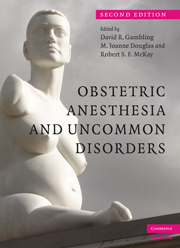Book contents
- Frontmatter
- Contents
- List of plates
- List of contributors
- Preface
- Section 1 Cardiovascular and respiratory disorders
- Section 2 Musculoskeletal disorders
- Section 3 Nervous system disorders
- Section 4 Metabolic disorders
- Section 5 Other disorders
- 17 Blood disorders
- 18 Infectious diseases in pregnancy
- 19 Dermatoses
- 20 Psychiatric disorders in pregnancy
- 21 Malignancy and pregnancy
- 22 Pregnancy and transplantation
- 23 Autoimmune diseases
- Index
- Plate Section
- References
23 - Autoimmune diseases
from Section 5 - Other disorders
Published online by Cambridge University Press: 19 October 2009
- Frontmatter
- Contents
- List of plates
- List of contributors
- Preface
- Section 1 Cardiovascular and respiratory disorders
- Section 2 Musculoskeletal disorders
- Section 3 Nervous system disorders
- Section 4 Metabolic disorders
- Section 5 Other disorders
- 17 Blood disorders
- 18 Infectious diseases in pregnancy
- 19 Dermatoses
- 20 Psychiatric disorders in pregnancy
- 21 Malignancy and pregnancy
- 22 Pregnancy and transplantation
- 23 Autoimmune diseases
- Index
- Plate Section
- References
Summary
Introduction
An autoimmune disease represents a pathological condition caused by an immune response directed against an antigen within the body of the host. The most accepted theory suggests that autoimmunity results from a failure of the normal regulation of the immune system (which contains many immune cells that recognize self antigens, but are normally suppressed). The exact etiology of these diseases remains unclear, although there are a number of factors that are implicated in their development, including infection, hormonal effect, drug exposure, and human leukocyte antigen (HLA) type. The incidence and activity of autoimmune diseases are particularly high in young women and hence their occurrence in parturients is not uncommon. During pregnancy, mother and fetus produce immunological factors to limit cell-mediated immunity and prevent fetal rejection, but the high estrogen environment may enhance immune function resulting in these demographic findings.
Rheumatoid arthritis
Rheumatoid arthritis (RA) is a chronic systemic disorder characterized by symmetrical polyarthritis, resulting in joint destruction and deformity. Diagnosis depends on an aggregation of clinical symptoms, signs, laboratory data, and radiological data (see Table 23.1). The joints primarily affected include the wrists, knees, shoulders, and metacarpal-phalangeal joints, with frequent sparing of the larger joints and spinal column. However, RA is a multisystem disease and extra-articular manifestations include lymphadenopathy, fatigue, anemia, weight loss, interstitial lung disease, pericarditis, subcutaneous nodules (rheumatoid nodules), vasculitis, neuropathy, renal disease, Sjögren syndrome (parotid and lacrimal hypertrophy, keratoconjunctivitis, vaginitis, xerostomia), and Felty syndrome (see Table 23.2).
- Type
- Chapter
- Information
- Obstetric Anesthesia and Uncommon Disorders , pp. 405 - 422Publisher: Cambridge University PressPrint publication year: 2008



